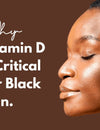
Winter Has Come, The Days Are Shorter, The Nights Are Colder...
Although the weather can make you feel down at times, the festive season is officially upon us and it's time to liven up the party; our hair, our skin and Winter wardrobe.
Everybody has various methods on styling their hair in the Winter and it can be tricky if you have type 4A-4C hair like me. Let's have a look at a few tips to help with tackling our hair during these harsh Winter months.
Hydration starts from within. Not only is drinking water healthy for your body, it's also healthy for your hair. It is said that we should consume around 8 glasses of water a day as part of a healthy lifestyle. The
water you drink is transported around your body, in this case; the roots of your hair to the tips. Your roots then soak up the water from your skin and hydrates your hair. If your hair roots are deprived of water
and are dehydrated, it will become brittle and dry. Your hair will stop growing and may even break. Spritzing your hair with water also makes styling manageable as your hair becomes softer.

Keeping your hair moist is important, especially during Winter when the conditions can break your hair. There are two methods that are used when moisturising our hair; the LOC method or the LCO Method. There are similar
methods just done in a different order. This method is a technique for moisturising kinky and coily hair. It starts by hydrating the hair with water or a water-based product which is the liquid, you then seal in
the moisture with oil and then applying a cream product to lock the hair cuticle which then prevents moisture loss. Below is an example of the LOC method and you can swap the last two steps to make a LCO method.

Step 1: 'L' stands for liquid, a water based leave in conditioner which moisturises your hair. Product Recommendations Include Cantu's Shea Butter Leave In Conditioning Cream and Shea Moisture Jamaican Black Castor Oil Leave-In Conditioner.
Step 2: 'O' stands for Oils (natural Oils or your preferred oil which helps your hair hold the water molecules). Product Recommendations: Jamaican Black Castor Oil, Extra Virgin Olive Oil, or Jojoba Oil.
Step 3: 'C' stands for cream (a creamy moisturiser which will then lock in the moisture). Product Recommendations: Shea Moisture Curl Enhancing Smoothie, or Cantu Shea Butter Natural Hair Coconut Curling Cream.
I go by the LCO method; which ever method you choose depends on what works better for your type of hair. Nevertheless, moisturised hair equals less breakage.
You should at least wash weekly and not too frequently as you will strip away some of your hair's natural oils. It's also better to use shampoo without sulphates which are becoming more popular as there are concerns that
shampoos with sulphates actually damage the hair and cause frizziness.
There are many different types of conditioners which can be used depending on your hair type and treatment. Deep conditioning should ideally be done weekly when you're washing your hair. They contain proteins and elements
that boost the moisture in your hair. At the moment I am using Cantu Deep Treatment Masque. I mix it with a bit of honey, raw shea butter and olive oil and steam under a shower cap with a hot towel wrapped around my
head to trap the heat in.
Protective styling is always a great idea for any season but works especially well for the Winter. It's a good style for keeping your ends protected from the cold weather. You just have to be careful to not plait
too tight along the edges of your hair or pull on them as this will result in hairloss. If you do find that your edges are thinning and you want to cover them up to look natural and fuller, the
Hair Foundation Kit by Ms Hair is the hair-saving tool that you need!
Headwraps are a quick and fun way of changing up your style and it allows your hair to breathe and relax. This is also an alternative form of protective styling. However, headwraps made from cotton can rub against your
edges causing them to thin over time. Wear a satin headscarf underneath the headwrap to
minimise breakage.

Satin & Silk headscarves are great for protecting edges, especially at night as they prevent your hair from being damaged caused by sleeping patterns. Friction from cottoned pillowcases drain our hair of moisture, thus resulting in strands being tugged and ripped throughout the night. When I go to bed I wear the Satin Sleeping Large Scarf Smooth Outside.
Trimming is an important part of haircare that I used to ignore. Ideally you should trim between 6-8 weeks. If you're not confident in trimming your own hair then let your hairdresser do it. Trimming your hair is necessary in getting rid of your split ends. It fights against breakage during the colder months and you will notice your hair growing a lot healthier and retaining its length.
Looking after our natural hair isn't easy...believe me, and a lot of time, effort and money does play a part in achieving healthy hair, especially when our products aren't produced for the masses. The good thing is
that there is always something new to be learnt and if we continue to share tips on haircare amongst ourselves we will all be wearing strong, healthy, kinky or coily crowns!
How Do You Prevent The Winter Season From Damaging Your Hair? Leave A Comment Below.

Contributor:
Azania
Fashion, Beauty and Lifestyle Blogger.




